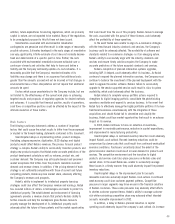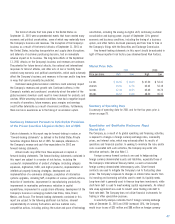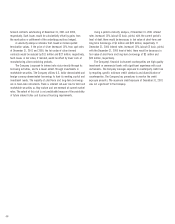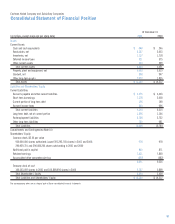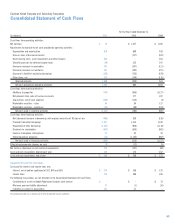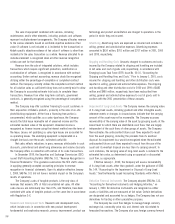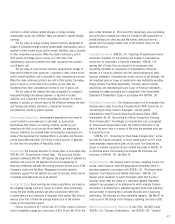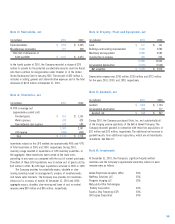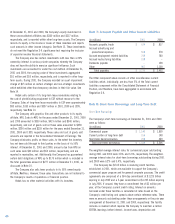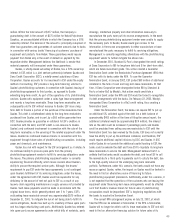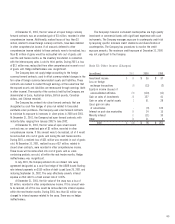Kodak 2001 Annual Report Download - page 57
Download and view the complete annual report
Please find page 57 of the 2001 Kodak annual report below. You can navigate through the pages in the report by either clicking on the pages listed below, or by using the keyword search tool below to find specific information within the annual report.
Company has never experienced non-performance by
any of its counterparties.
Cash Equivalents All highly liquid investments with a remaining
maturity of three months or less at date of purchase are considered to
be cash equivalents.
Marketable Securities and Noncurrent Investments The Company has
evaluated its investment policies consistent with SFAS No. 115,
“Accounting for Certain Investments in Debt and Equity Securities” which
requires that investment securities be classified as either held-to-
maturity, available-for-sale or trading. The Company’s debt and equity
investment securities are classified as held-to-maturity and available-
for-sale, respectively. Held-to-maturity investments are carried at
amortized cost and available-for-sale securities are carried at fair value,
with the unrealized gains and losses reported in Shareholders’ Equity
under the caption Accumulated Other Comprehensive Income (Loss).
At December 31, 2001, the Company had short-term investments
classified as held-to-maturity of $3 million. These investments were
included in other current assets. In addition, the Company had long-term
marketable securities and other investments classified as held-to-
maturity and available-for-sale equity securities of $1 million and $33
million, respectively, which were included in other long-term assets at
December 31, 2001.
At December 31, 2000, the Company had short-term investments
classified as held-to-maturity of $5 million, which were included in other
current assets. In addition, the Company had long-term marketable
securities and other investments classified as held-to-maturity and
available-for-sale equity securities of $5 million and $49 million,
respectively, which were included in other long-term assets at December
31, 2000.
Inventories Inventories are stated at the lower of cost or market. The cost
of most inventories in the U.S. is determined by the “last-in, first-out”
(LIFO) method. The cost of all of the Company’s remaining inventories in
and outside the U.S. is determined by the “first-in, first-out” (FIFO) or
average cost method, which approximates current cost. The Company
provides inventory reserves for excess, obsolete or slow-moving inventory
based on changes in customer demand, technology developments or
other economic factors.
Properties Properties are recorded at cost, net of accumulated
depreciation. The Company principally calculates depreciation expense
using the straight-line method over the assets’ estimated useful lives,
which are as follows:
Years
Buildings and building improvements 10–40
Machinery and equipment 3–20
Maintenance and repairs are charged to expense as incurred. Upon sale
or other disposition, the applicable amounts of asset cost and
accumulated depreciation are removed from the accounts and the net
amount, less proceeds from disposal, is charged or credited to income.
Goodwill Goodwill represents the excess of purchase price over the fair
value of the net assets acquired, and for the three-year period ended
December 31, 2001, goodwill was charged to earnings on a straight-line
basis over the period estimated to be benefited, generally ten years. See
Note 5.
Effective January 1, 2002, the Company will be accounting for
goodwill under SFAS No. 142, “Goodwill and Other Intangible Assets.”
Under SFAS No. 142 the Company will no longer amortize its goodwill
which, as of December 31, 2001, had a net balance of $948 million.
Under SFAS No. 142, the Company’s goodwill will be subject to an
impairment test, at least annually, and therefore, will only be charged to
operations to the extent it has been determined to be impaired. See the
Recently Issued Accounting Standards within Note 1.
Revenue The Company’s revenue transactions include sales of the
following: products; equipment; services; equipment bundled with
products and/or services; and integrated solutions. The Company
recognizes revenue when realized or realizable and earned, which is when
the following criteria are met: persuasive evidence of an arrangement
exists; delivery has occurred; the sales price is fixed and determinable;
and collectibility is reasonably assured. At the time revenue is
recognized, the Company provides for the estimated costs of warranties
and reduces revenue for estimated returns.
For product sales, the recognition criteria are generally met when
title and risk of loss have transferred from the Company to the buyer,
which may be upon shipment or upon delivery to the customer sites,
based on contract terms or legal requirements in foreign jurisdictions.
Service revenues are recognized as such services are rendered.
For equipment sales, the recognition criteria are generally met when
the equipment is delivered and installed at the customer site. In
instances in which the agreement with the customer contains a customer
acceptance clause, revenue is deferred until customer acceptance is
obtained, provided the customer acceptance clause is considered to be
substantive. For certain agreements, the Company does not consider
these customer acceptance clauses to be substantive because the
Company can and does replicate the customer acceptance test
environment and performs the agreed upon product testing prior to
shipment. In these instances, revenue is recognized upon installation of
the equipment.
55


